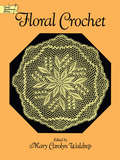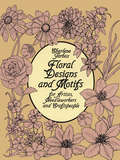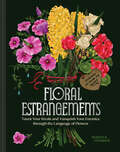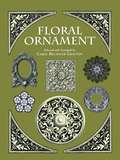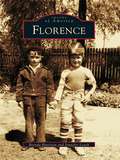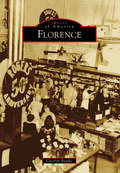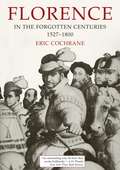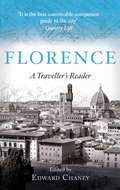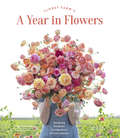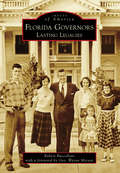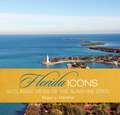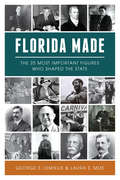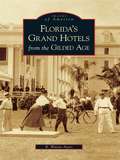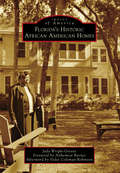- Table View
- List View
Floral Crochet
by Mary Carolyn WaldrepRenewed interest in needlecraft projects -- particularly in crocheted items used as accent pieces -- has created a new demand for attractive floral patterns. Fashionable during the first half of the twentieth century, these popular designs ranged from the simple, stylized motifs found in edgings and tablecloths to superb bouquets of three-dimensional blossoms used in bedspreads, placemats, and doilies.With the patterns in this splendid collection, crocheters can again re-create many of the same eye-catching designs that were once presented in now-rare thread-company instruction booklets of the 1940s and '50s. Included here are designs for a delicate three-piece filet crochet vanity set displaying the timeless beauty of the daffodil; exquisite edgings depicting violets, fuchsias, and begonias; a lovely bedspread titled Friendship Garden; a Rose O' Summer doily centerpiece; a breathtaking doily set titled Forget-Me-Not Swirl; a variety of colorful pansy motifs incorporated in a bedspread, refreshment set, and two different doilies; a lacy lily-of-the-valley doily; and two dozen other irresistible designs.Easy-to-follow, step-by-step instructions and 36 finely detailed photographs enable crocheters at all levels to create a treasure chest of stunning, heirloom-quality items. In addition, a brief introduction provides helpful hints on how to care for completed projects through proper washing and blocking.
Floral Designs and Motifs for Artists, Needleworkers and Craftspeople
by Charlene TarboxFlowers are among nature's most beautiful creations, infinitely varied in form and texture, strikingly vivid in color. Now you can bring the freshness of a whole garden of exquisite flowers to your needlework and art projects with this versatile collection of original floral designs. Noted illustrator and fabric designer Charlene Tarbox brings sophisticated pen and ink techniques and design ingenuity to 136 floral motifs presented here for copyright-free use. A wide variety of plants and flowers are represented, spanning the seasons from early spring crocuses to autumn chrysanthemums. You'll find popular flowers in a number of horticultural varieties, native wildflowers, houseplants, and shrubs. Included in the selection are the Aztec Lily, African Violet, Bog Rosemary, Camellia, Dogwood, Evening Primrose, Forget-me-not, Gloxinia, Holly, Sacred Lotus, Magnolia, Oak, Orchid, Wild Strawberry, Parrot Tulip, and dozens of other floral motifs. These crisply rendered designs lend themselves to a myriad of decorative applications: needlework and craft projects, illustrations, borders, frames, and corner cuts for advertisements, stationery, book covers, menus, invitations, almost anything that would be enhanced by an elegant floral touch.Needleworkers, craftspeople, graphic artists, illustrators, and anyone needing floral illustrations will find this volume a handy source of exceptional, ready-to-use designs . . . costing only pennies apiece.
Floral Estrangements: Taunt Your Rivals and Vanquish Your Enemies through the Language of Flowers
by Rebecca FishbeinFlowers for when you love them . . . not. The ultimate guide to finding new and fragrant ways to channel your frustrations and fuel your revenge fantasies with some common (and not-so-common) vengeful plants, as well as suggested bouquets to blight your nemeses.Is there anything more savage than an archly composed bouquet? The Victorians didn’t think so, which is why their flower symbols weren’t just endearing—they were also cheeky, rude, and downright hostile. This illustrated floriography will help you choose the perfect Floral Estrangement for your situation, such as: The “Maybe You Shouldn't Have Given Me Your Phone Password” (Yellow Chrysanthemum, Birdsfoot Trefoil, Basil, Yellow Rose, Tansy) The “Still Thinking about the $1K I Spent to Be a Bridesmaid at Your Destination Wedding” (Black-Eyed Susan, Birdsfoot Trefoil, Delphinium, Orange Lily) The “His Mommy Issues Are Now Your Problem” (Withered White Rose, Pine, Delphinium) With incredible, subtly hostile illustrations of flowers throughout, this is a sumptuous, decadent, guilty pleasure of a gift or self-purchase. As a modern bard says, “Don’t get sad, get even.”A FRESH TAKE FLOWER BOOK: It’s the perfect time for a book on the language of flowers that focuses on the darker side of its symbolism. For anyone who fantasizes about sending your awful ex a message on Valentine’s Day, this book includes hilarious (and informative!) tips for you. MODERN LOVE (AND HATE): This hilarious guide to flowers one should never send is pitch-perfect for iconoclasts who love to buck the trends and fans of such vengeful entertainments as Bridgerton and Do Revenge.Perfect for: Fans of Wicked Plants and Floriography: An Illustrated Guide to the Victorian Language of Flowers People who hate Valentine’s Day Gift-giving to a recently dumped friend or relative Botany enthusiasts The eternally vengeful and embittered
Floral Ornament (Dover Pictorial Archive Ser.)
by Carol Belanger GraftonGraphic artists and craftworkers in search of attractive and unusual floral motifs will find them in this rich treasury of exquisite designs. Carol Belanger Grafton has selected over 350 handsome floral and foliated arrangements from a wide variety of Victorian-era sources. Reproduced from such rare publications as L'Art Pour Tous, The Art Journal, The Illustrated London News, Harper's Weekly, and The British Printer, these lovely images appear in a wide variety of configurations -- as decorative embellishments on a saucer and teacup, on picture frames and wall sconces, as flowing patterns that lend themselves well for use as frames and borders, and much more. These imaginative accents will not only enhance such print projects as brochures, newsletters, posters, signs, and catalog copy, they'll also serve as a source of inspiration to anyone working in the arts and crafts.
Floral Stained Glass Pattern Book
by Ed Sibbett Jr.Floral designs are inevitably popular with stained glass workers. These 96 lovely floral patterns rendered by celebrated designer Ed Sibbett, Jr., are among the most graceful and appealing for use in this medium. Included are irises, poppies, lilies, and tulips in a variety of styles, abstract and geometric patterns, and other exquisite designs adaptable to innumerable projects.
Florence
by Jennifer Leach Brenda HarrisonOriginally formed as a railroad terminal, the city of Florence, South Carolina, has developed from a township with agrarian roots into a city that is an indispensable medical hub and a place of flourishing business and industry. After being named for Florence Henning Harllee, daughter of the first president of the Wilmington & Manchester Railroad, Florence was chartered in 1871 and then incorporated on December 24, 1890. It is now the largest city in the northeastern portion of South Carolina, and its humble beginnings have given way to a heritage rich in tradition and southern charm. Images of America: Florence showcases storied photographs, culled from personal collections, family archives, the City of Florence, and local businesses. Each view, coupled with fact-filled captions, reveals yet another part of the story of this fine example of a genteel, southern city.
Florence
by Richard J. GoyEach year, millions of visitors travel to Florence to admire the architectural marvels of this famous Renaissance city. In this compact yet comprehensive volume, architect and architectural historian Richard J. Goy offers a convenient, accessible guide to the city's piazzas, palazzos, basilicas, and other architectural points of interest, as well as pertinent historical details regarding Florence's unique urban environment. Clearly laid out and fully illustrated, this handbook is designed around a series of expertly planned walking tours that encompass not only the city's most admired architectural sites, but also its lesser-known gems. Maps are tailored to each walking tour and provide additional references and insights, along with introductory chapters on the city's architectural history, urban design, and building materials and techniques. Featuring a complete bibliography, glossary of key terms, and other useful reference materials, Goy's guide will appeal both to travelers who desire a greater architectural context and analysis than that offered by a traditional guide and to return visitors looking to rediscover Florence's most enchanting sites.
Florence (Images of America)
by Carolyn BarskeOn the banks of the Tennessee River, below the once-formidable Muscle Shoals in northwest Alabama, sits the vibrant community of Florence. In the early 19th century, the Chickasaw Nation ceded lands to the US government, and in 1818 the Cypress Land Company held its first auction. The town grew quickly because of the efforts of the company's founders, which included Gen. John Coffee; John McKinley, who later sat on the US Supreme Court; and James Jackson, whose imported Thoroughbred horses became the bloodstock for some of Kentucky's finest racehorses. Schools, churches, hotels, and businesses soon filled the streets. For almost 200 years, the town of Florence has continued to grow, becoming home to the University of North Alabama and people like the "Father of the Blues," W.C. Handy; Maud Lindsay, who operated the first free kindergarten in the state; and four governors in Edward A. O'Neal, Emmett O'Neal, Robert M. Patton, and Hugh McVay.
Florence Revisited (Images of America)
by Florence Historical Society Book CommitteeKnown as "the Community with Character at the Bend in the River," Florence has a fascinating past and rich heritage. First inhabited by the Lenni-Lenape tribes, Florence is believed to be named after the daughter of Charles Macalester of Philadelphia, one of the area's first landowners who was instrumental in dividing Florence into lots for future homes in the early 1850s. Some early residents were decoy carvers, whose labors are in high demand today under the classification of Delaware River decoys, while others worked in foundries or as storekeepers, farmers, and fishermen. Picking up where Florence left off, Florence Revisited will provide information and enjoyment for those who are proud to call this town home, and it will spark an interest for old pictures, stories, and news articles about early families in Florence, New Jersey.
Florence in the Forgotten Centuries, 1527–1800: A History of Florence and the Florentines in the Age of the Grand Dukes
by Eric CochraneThe city of Florence has long been admired as the home of the brilliant artistic and literary achievement of the early Renaissance. But most histories of Florence go no further than the first decades of the sixteenth century. They thus give the impression that Florentine culture suddenly died with the generation of Leonardo, Machiavelli, and Andrea del Sarto. Eric Cochrane shows that the Florentines maintained their creativity long after they had lost their position as the cultural leaders of Europe. When their political philosophy and historiography ran dry, they turned to the practical problems of civil administration. When their artists finally yielded to outside influence, they turned to music and the natural sciences. Even during the darkest days of the great economic depression of the late seventeenth and early eighteenth centuries, they succeeded in preserving—almost alone in Europe—the blessings of external peace and domestic tranquility.
Florence: A Traveller's Reader
by Edward ChaneyOf all Italian cities, Florence has always had the strongest English accent: the Goncourt brothers in 1855 called it 'ville tout anglaise'. Though that accent is diminished now, Florence remains for the English-speaking traveller what it always has been - one of the best loved, and most visited, of cities.In this Traveller's Reader, Florence's rich and glorious past is brought vividly to life for the tourist of today through the medium of letters, diaries and memoirs of travellers to Florence from past centuries and of the Florentines themselves. The extracts chosen by cultural historain Edward Chaney include: Boccaccio on the Black Death; Vasari on the building of Giotto's Campanile; an eye-witness account of the installation of Michaelangelo's 'David'; the death of Elizabeth Barrett Browning at the Casa Guidi; and D. H. Lawrence and Dylan Thomas on twentieth-century Florentine society. Sir Harold Acton's introduction provides a concise history of the city from its origins, through its zenith as a prosperous city state which, under the Medici, gave birth to the Renaissance, and up to the Arno's devastating flood in 1966. Sir Harold Acton, man of letters, historian, aesthete, novelist and poet, spent most of his life in Florence. Among his best-known books is The Last Medici, Memoirs of an Aesthete.Currently Professor of Fine and Decorative Arts at Southampton Solent University, Edward Chaney is an honorary life member of the British Institute of Florence and taught at the University of Pisa for six years.
Floret Farm's A Year in Flowers: Designing Gorgeous Arrangements for Every Season
by Erin BenzakeinLearn how to buy, style, and present seasonal flower arrangements for every occasion.With sections on tools, flower care, and design techniques, Floret Farm's A Year in Flowers presents all the secrets to arranging garden-fresh bouquets.Featuring expert advice from Erin Benzakein, world-renowned flower farmer, floral designer, and bestselling author of Floret Farm: Cut Flower Garden, this book is a gorgeous and comprehensive guide to everything you need to make your own incredible arrangements all year long, whether harvesting flowers from the backyard or shopping for blooms at the market.• Includes an A–Z flower guide with photos and care tips for more than 200 varieties.• Simple-to-follow advice on flower care, material selection, and essential design techniques• More than 25 how-to projects, including magnificent centerpieces, infinitely giftable posies, festive wreaths, and breathtaking bridal bouquetsFloret Farm's A Year in Flowers offers advice on every phase of working with cut flowers—including gardening, buying, caring for, and arranging fresh flowers.Brimming with indispensable tips and hundreds of vibrant photographs, this book is an invitation to live a flower-filled life and perfect for anyone who loves flowers.• The definitive guide to flower arranging from the biggest star in the farm-to-centerpiece movement• Perfect for flower lovers, avid and novice gardeners, floral designers, wedding planners, florists, small farmers, stylists, designers, crafters, and those passionate about the local floral movement• For those who loved Floret Farm's Cut Flower Garden by Erin Benzakein, The Flower Recipe Book by Alethea Harampolis, Seasonal Flower Arranging by Ariella Chezar, and The Flower Chef by Carly Cylinder
Floret Farm's Cut Flower Garden: Grow, Harvest, and Arrange Stunning Seasonal Blooms
by Erin Benzakein#1 Amazon Best Seller — Welcome to the farm!The Cut Flower Garden: Erin Benzakein is a florist-farmer, leader in the locaflor farm-to-centerpiece movement, and owner of internationally renowned Floret Flower Farm in Washington's lush Skagit Valley.A stunning flower book: This beautiful guide to growing, harvesting, and arranging gorgeous blooms year-round provides readers with vital tools to nurture a stunning flower garden and use their blossoms to create show-stopping arrangements.Floret Farm's Cut Flower Garden: Cut Flower Garden is equal parts instruction and inspiration—a book overflowing with lush photography of magnificent flowers and breathtaking arrangements organized by season. Find inspiration in this lush flower book:Irresistible photos of Erin's flower farm that showcase exquisite bloomsTips for growing in a variety of spaces and climatesStep-by-step instructions for lavish garlands, airy centerpieces, and romantic floral décor for every seasonIf you liked Paris in Bloom, you'll love Floret Farm's Cut Flower Garden.
Floret Farm's Discovering Dahlias: A Guide to Growing and Arranging Magnificent Blooms
by Erin BenzakeinA stunning guide to growing, harvesting, and arranging gorgeous dahlia blooms from celebrated farmer-florist and New York Times bestselling author Erin Benzakein, founder of Floret Flower Farm.World-renowned flower farmer and floral designer Erin Benzakein reveals all the secrets to growing, cultivating, and arranging gorgeous dahlias. These coveted floral treasures come in a dazzling range of colors, sizes, and forms, with enough variety for virtually every garden space and personal preference, making them one of the most beloved flowers for arrangements.In these pages, readers will discover:• Expert advice for planting, harvesting, and arranging garden-fresh dahlias• A simple-to-follow overview of the dahlia classification system• An A–Z guide with photos and descriptions of more than 350 varieties• Step-by-step how-to's for designing show-stopping dahlia bouquets that elevate any occasionExpert Author: Erin Benzakein's gorgeous flowers are celebrated throughout the world. Her book Floret Farm's A Year in Flowers was a New York Times bestseller and her first book, Floret Farm's Cut Flower Garden, won the American Horticultural Society Book Award.Filled with Wisdom: Overflowing with hundreds of lush photographs and invaluable advice, DISCOVERING DAHLIAS is an essential resource for gardeners and a must-have for anyone who loves flowers, including flower lovers, avid and novice gardeners, floral designers, florists, small farmers, stylists, and designers.
Floriculture: Designing And Merchandising (Third Edition)
by Charles GrinerThis third edition introduces students to the career possibilities in the floral industry and provides basic instruction in the techniques of floral design and merchandising.
Florida Architecture of Addison Mizner (Dover Architecture)
by Addison MiznerAn architect who excelled at transforming an architectural fantasy into a practical, livable home, Addison Mizner was one of the most original and influential designers America has produced. The houses, clubs, and shops he built for the wealthy of Palm Beach and Boca Raton, Florida, evince a brilliant grasp of how to blend a building with the environment, how to adapt it to the climate and how to situate it in order to make the best use of the elements of sea, light, and air.This lavishly illustrated volume recaptures the genius of Addison Mizner. It contains over 180 photographs -- both interiors and exteriors -- depicting more than 30 residences, including Mizner's own, plus those of Harold Vanderbilt, Rudman Wanamaker, A. J. Drexel Biddle, Jr., Edward Shearson, Mrs. Hugh Dillman, and many more. Also covered are such landmark Mizner creations as the Everglades Club, Via Parigi, the Singer Building, The Cloister at Boca Raton, the Riverside Baptist Church at Jacksonville, and many others.A superb appreciation by author and journalist Ida M. Tarbell offers fascinating glimpses into Mizner's early life and background, and how it prepared him to develop architecture that "belonged" in the Florida landscape. Inspired by the beauty and charm of the villas and palaces of the Mediterranean, Mizner designed in a Spanish Colonial style far better suited to the subtropical sun and climate of Florida than the transplanted houses of the North at first so common in the state. A new Introduction by Mizner scholar Donald W. Curl offers an additional appreciation of the architect and his innovative and imaginative conceptions, which continue to win new admirers among connoisseurs of classic design.Reproduced from a rare edition much sought after by collectors, this inexpensive volume will be welcomed by architects, students and historians of architecture -- and anyone interested in the life and achievements of Addison Mizner.
Florida Atlantic University
by Donald W. CurlBuilt on the site of the abandoned Boca Raton Army Air Field, Florida Atlantic niversity, in the short period since its founding in the 1960s, has come to be a well-regarded institution of higher education in Florida. Overcoming such early challenges as poor road systems in the area, unsuccessful recruitingefforts, and student unrest arising from the Civil Rights Movement and the conflict in Vietnam, university leaders tirelessly promoted the vision that would eventually become a reality--Florida Atlantic University becoming a successful regional university. This engaging pictorial retrospective begins in the days prior to FAU's first semester and depicts the early players in the school's establishment, the construction of the first campus buildings, and the legislative planning and funding that made much of it possible. Fascinating original photographs capture student life through the decades--athletic teams and social clubs, dormitories and dining halls, classes and commencement ceremonies--as well as pay tribute to the faculty members and administrators who have helped to shape not just auniversity, but the hearts and minds of countless students through the years.
Florida Birds: A Birdwatcher Discovers the Sunshine State
by Ken JanesWading birds, raptors, waterfowl, pelicans, gulls & terns, shorebirds, and songbirds. These are the types of birds Florida birdwatchers can see and learn about in Ken Janes&’ stunning photobook Florida Birds: A Birdwatcher Discovers the Sunshine State. With all original photography by Janes and informational sections for each bird listed, those interested in the year-long hobby of Florida birdwatching will be able to not only learn key facts from this book but also display it in their homes as a piece of photo art.Birdwatching and other birding activities are seasonal in most parts of the country but can take place year-round in Florida because of the warmer climate. Janes, a Mainer until winter when he travels to his Florida home, shows northerners and southerners alike what unique aviary life can be found in the Sunshine State. Janes takes a conservationist approach to his work and makes it clear to readers how certain species of birds have been negatively affected by harmful practices and chemicals, like the effect of DDT on Osprey.
Florida Governors: Lasting Legacies
by Gov. Wayne Mixson Robert BuccellatoThe state of Florida has a unique place in the annals of national history and has been a constant contributor to the country's identity. The 51 men who have served as the state's governors are an essential part of its complex identity and have produced resonant material for historians of all ages. They have been farmers, generals, boat captains, restaurant owners, presidents, and sons of presidents. They have been given the office by both popular mandate and the happenstance of fate. These individuals have represented virtually every category of what it means to be a Floridian. Their lasting legacies can be felt every day by the state's citizens. Since the drainage of the Everglades and the transformation of swamplands into beachfront paradises, Florida has lured Americans from various states to its sunny shores. It has seceded from the Union, determined the final verdict in many presidential elections, was the site of railroad monopolies, developed into a playground of the rich, and is the birthplace of a new kind of theme park--all while being led by these distinct individuals who, at their core, were Floridians first.
Florida Icons: Fifty Classic Views of the Sunshine State (Icons)
by Roger L. HammerICONSBeautifully illustrated, timeless celebrations of the spirit of placeWhat makes Florida, Florida? Glacier National Park, Glacier National Park? Through beautiful color photographs and short, evocative essays, learn the stories behind fifty of the best-known and beloved iconic places, foods, inventions, buildings, and traditions that reflect the personality of these special places.=
Florida Lighthouses
by John HairrSporting the second-longest coastline in the United States, Florida has over 8,000 miles of sparkling beaches and waterfront property. This valuablelandscape and the region's position between the Atlantic Ocean and the Gulf of Mexico made Florida key in the early expansion of American trade routes, but the state's several capes and dangerous reefs, rocks, and shoals made travel quite perilous to unwary mariners. When commerce and traffic began to grow between ports on the East Coast and along the Gulf of Mexico in the nineteenth century, it became necessary to construct aids to navigation along the state's long and treacherous coast. Lighthouses were the solution. Constructed in a variety of styles and sizes, Florida's lighthouses were erected on what, at the time, were some of the most desolate regions of the southeastern United States and included lonely offshore islands. Manned and inhabited by vigilant keepers and their families, these towers illuminated the dark seas and provided the beacon that guided lost travelers. Large brick structures watched over St. Augustine, Pensacola, and Ponce de Leon Inlet; iron skeletons towered over Crooked River and Hillsboro Inlet; and screwpile lighthouses stood as sentinels in the waters off the Florida Keys.
Florida Made: The 25 Most Important Figures Who Shaped the State
by Laura E. Mize George S. LeMieuxFlorida is in many ways both the oldest and newest of the megastates. Once an insect-ridden swampland, it is now a top destination for tourism, business, agriculture and innovation. The ideas and actions of a colorful cast of characters--from beloved cultural icons to political heroes and even a socialist dictator--transformed the peninsula. A Barbados native rescued Florida's orange industry after the catastrophic 1835 freeze. Known as the "Grande Dame of the Everglades," Marjory Stoneman Douglas worked tirelessly to save the state's vast, incomparable wetlands from annihilation in the early twentieth century. In the mid-1800s, a Florida doctor developed a precursor to modern air conditioning. Join former U.S. senator George LeMieux and journalist Laura Mize as they profile and rank, according to impact, the twenty-five trailblazers who have changed the state forever.
Florida Railroads in the 1920's
by Gregg TurnerFlorida's railroads emerged in the 1830s amid Native American upheaval and territorial colonization. Many periods of development marked this fascinating heritage, but one era towers above the rest: the 1920s. It was then that Florida experienced a colossal land boom, one of the greatest migration and building stories in American history. People poured into the state as never before, real estate traded hands at breakneck speed, and the landscape added countless new homes, hotels, apartments, and commercial buildings. Florida's biggest railroads--the Atlantic Coast Line, Seaboard Air Line, and Florida East Coast--were unprepared for the tidal wave of traffic. Thus, the "Big Three" had to rapidly expand and increase capacity. Dozens of projects unfolded at great cost, by one estimate over $100 million. When the building frenzy ended, the railway map of the state stood at its greatest extent--some 5,700 miles. Further, the frequency of railway service within and to the Sunshine State reached an unprecedented level, never again to be repeated.
Florida's Grand Hotels from the Gilded Age
by R. Wayne AyersFlorida in the late 1800s was a paradise waiting to be discovered. During this period, two visionary tycoons of the Gilded Age set out on separate ventures that would transform the Sunshine State from America's last frontier into a destination for the rich and famous. The grand hotels that Henry M. Flagler and Henry B. Plant opened at their planned resort sites offered a fantasy stay surrounded by all the accoutrements expected by sophisticated, Gilded Age patrons. Florida's Grand Hotels from the Gilded Age provides a look at these magnificent structures during their glory years, along with the fashionable entertainment and social and recreational pastimes that engaged their gilded guests.
Florida's Historic African American Homes (Images of America)
by Jada Wright-GreeneThe state of Florida has a rich history of African Americans who have contributed to the advancement and growth of today. From slaves to millionaires, African Americans from all walks of life resided in cabins, homes, and stately mansions. The lives of millionaires, educators, businessmen, community leaders, and innovators in Florida's history are explored in each residence. Mary McLeod Bethune, A.L. Lewis, and D.A. Dorsey are a few of the prominent African Americans who not only resided in the state of Florida but also created opportunities for other blacks to further their lives in education and ownership of property and to have a better quality of life. One of the most humanistic traits found in history is the home of someone who has added something of value to society. Today, some of these residences serve as house museums, community art galleries, cultural institutions, and monuments that interpret and share the legacy of their owners.
